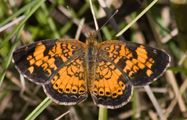Native Plants
Search for native plants by scientific name, common name or family. If you are not sure what you are looking for, try the Combination Search or our Recommended Species lists.
Symphyotrichum ericoides var. ericoides
Symphyotrichum ericoides (L.) G.L. Nesom var. ericoides
White Heath Aster, Heath Aster, White Aster, White Prairie Aster
Asteraceae (Aster Family)
Synonym(s): Aster ericoides, Aster ericoides var. prostratus, Aster exiguus, Aster multiflorus, Aster multiflorus var. exiguus, Aster multiflorus var. prostratus, Aster polycephalus, Lasallea ericoides, Symphyotrichum ericoides var. prostratum, Virgulus ericoides
USDA Symbol: SYERE
USDA Native Status: L48 (N), CAN (N)
Heath Aster is a bushy, grayish, 1-3 ft. perennial with densely clustered, miniature, daisy-like, usually white flowers. The tiny leaves resemble those of the heath plant.
Plant Characteristics
Duration: PerennialHabit: Herb
Size Notes: Up to about 3 feet tall.
Fruit: Fruit is a cypsela (pl. cypselae). Though technically incorrect, the fruit is often referred to as an achene.
Bloom Information
Bloom Color: White , Pink , BlueBloom Time: Aug , Sep , Oct , Nov
Bloom Notes: Ray flowers usually white, rarely pink or bluish.
Distribution
USA: AR , AZ , CO , CT , DE , IA , IL , IN , KS , MA , MD , ME , MI , MN , MO , MS , ND , NE , NH , NJ , NM , NY , OH , OK , PA , RI , SD , TN , TX , VA , VT , WI , WVCanada: AB , MB , ON , QC , SK
Native Distribution: ME to PA & Man., s. to MS and Mex.
Native Habitat: Dry prairies; roadsides
Growing Conditions
Water Use: LowLight Requirement: Sun
Soil Moisture: Dry
Soil Description: Dry soils.
Conditions Comments: Heath aster is a bushy, grayish, perennial with densely clustered, miniature, daisy-like, white flowers. The tiny leaves resemble those of the heath plant.
Benefit
Conspicuous Flowers: yesAttracts: Butterflies
Larval Host: Pearl Crescent
Nectar Source: yes
Deer Resistant: No
Value to Beneficial Insects
Special Value to Native BeesSupports Conservation Biological Control
This information was provided by the Pollinator Program at The Xerces Society for Invertebrate Conservation.
Butterflies and Moths of North America (BAMONA)
|
Pearl Crescent (Phyciodes tharos)  Larval Host |
Propagation
Description: Best propagated by division of mature plants which produce numerous, easily-separated rhizomes. Divide in late fall or very early spring. Germination of seed is usually quite low.Seed Treatment: Seeds require dry stratification.
Commercially Avail: yes
From the National Organizations Directory
According to the species list provided by Affiliate Organizations, this plant is on display at the following locations:Lady Bird Johnson Wildflower Center - Austin, TX
Texas Parks and Wildlife Department - Austin, TX
Herbarium Specimen(s)
NPSOT 0621 Collected Nov 5, 1993 in Bexar County by Judith C. BerryNPSOT 1121 Collected Oct 12, 1994 in Bexar County by Harry Cliffe
NPSOT 0617 Collected Oct 30, 1993 in Comal County by Mary Beth White
NPSOT 0590 Collected Oct 19, 1990 in Comal County by Harry Cliffe
NPSOT 0978 Collected Oct 30, 1994 in Bexar County by Mike Fox
Bibliography
Bibref 1186 - Field Guide to Moths of Eastern North America (2005) Covell, C.V., Jr.Bibref 1185 - Field Guide to Western Butterflies (Peterson Field Guides) (1999) Opler, P.A. and A.B. Wright
Bibref 946 - Gardening with Prairie Plants: How to Create Beautiful Native Landscapes (2002) Wasowski, Sally
Search More Titles in Bibliography
Web Reference
Webref 38 - Flora of North America (2019) Missouri Botanical Garden, St. Louis, MO & Harvard University Herbaria, Cambridge, MA.Webref 23 - Southwest Environmental Information Network (2009) SEINet - Arizona Chapter
Additional resources
USDA: Find Symphyotrichum ericoides var. ericoides in USDA PlantsFNA: Find Symphyotrichum ericoides var. ericoides in the Flora of North America (if available)
Google: Search Google for Symphyotrichum ericoides var. ericoides
Metadata
Record Modified: 2023-01-20Research By: NPIS, LAS